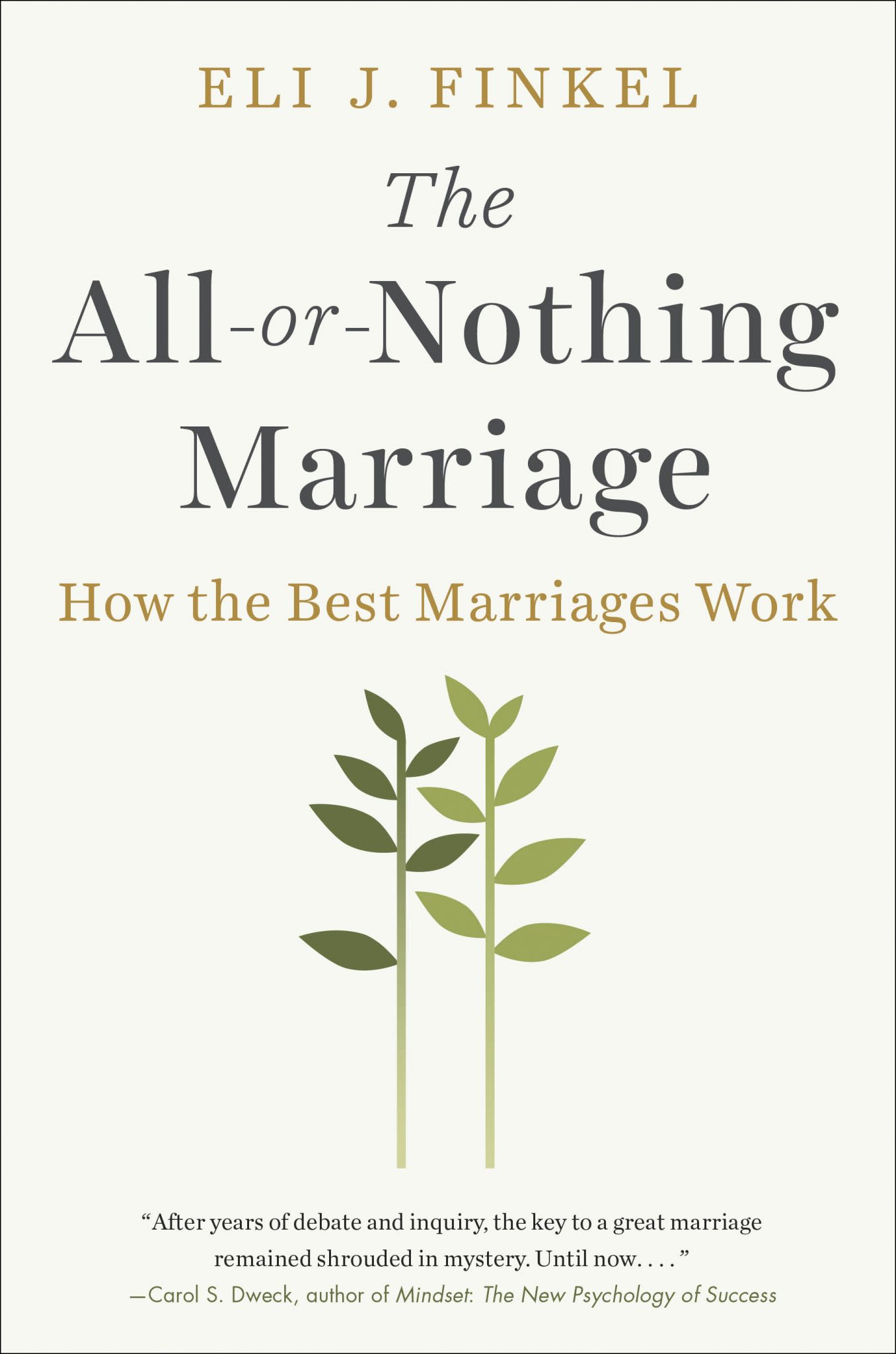Why do we marry today?
According to Eli Finkel’s The All-or-Nothing Marriage: How the Best Marriages Work, we get married—and should get married—for our individual wellbeing.
Finkel—a professor of psychology at Northwestern University—says we desire more from potential spouses than in previous eras: not just shelter and survival, or love and intimacy; we demand self-actualization, in an “all-or-nothing” paradigm of personal fulfillment. Finkel argues that such lofty expectations lead to more fulfilling marriages, but also with fewer couples able to attain them.
The book follows a historical argument to explain how we came to this understanding of marriage, and to suggest how we can make it work. According to Finkel, marriage in America has undergone three eras: pragmatic, love-based, and self-expressive.

The All-or-Nothing Marriage: How the Best Marriages Work
Eli Finkel
Eli J. Finkel—a professor of psychology at Northwestern University—says we desire more from potential spouses than in previous eras: not just shelter and survival, or love and intimacy; we demand self-actualization, in an “all-or-nothing” paradigm of personal fulfillment. Finkel argues that such lofty expectations lead to more fulfilling marriages, but also with fewer couples able to attain them.
In the colonial era, marriage followed practical dictates centered on economic survival. Spouses often worked together in the family farm, shop, or business, enrolling the aid of multiple children in the effort to survive.
We desire more from potential spouses than in previous eras: not just shelter and survival, or love and intimacy; we demand self-actualization, in an ‘all-or-nothing’ paradigm of personal fulfillment.
Then developments like urbanization and industrialization allowed people more amenable lives in cities, and the possibility that a single person could gain her own livelihood through wage labor. This, together with the Enlightenment’s celebration of the individual will and Romanticism’s elevation of feelings and love, encouraged people to desire companionship and intimacy when considering prospective spouses. The love-based marriage became more about shared feelings than shared tasks.
Factories and offices were not yet hospitable environments for women, however, so the love-based era culminated in the 1950s breadwinner-homemaker model ushered in by American prosperity, the advent of the automobile, and white middle-class flight to the suburbs. Men and women started to occupy distinct spheres and live according to roles more differentiated than in much of human history.
Interestingly, Finkel notes that our image of “traditional marriage” is a recent phenomenon. While previous ages celebrated, for instance, a woman who “works with willing hands . . . provides food for her household [and] considers a field and buys it” (Prov. 31), a mid-20th century “marker of social status” became the possibility of women’s almost exclusive dedication to childrearing and homemaking.
A number of developments since the 1960s—the introduction of home appliances, the increasing education of women, the advent of a postindustrial economy that employed women and men in shared offices—brought men and women closer in work environments and in the home. Much of this change should be celebrated, as we gained women’s contributions beyond their contributions as wives and mothers (for example, scientists and heads of state); women could choose to be full-time homemakers out of a sense of calling and not just as a social default, and fathers became more engaged in the care and education of their children.
Today’s Self-Expressive Marriage
But The All-or-Nothing Marriage ends up affirming virtually all trends since the 1960s leading to today’s self-expressive marriage that prizes spouses’ personal fulfillment above all. These trends include the notions that marriage is just one of many legitimate romantic arrangements; divorce is a common, if unfortunate, procedure; children are optional (and costly); consensual non-monogamy is acceptable; and marriage can be redefined to include members of the same-sex along with the gender fluid. The result is a celebration of almost every consensual romantic configuration. Stephanie Coontz is quoted approvingly:
People want to be monogamous or promiscuous, they want kids or they don’t want kids, they want this or they want that. For centuries, they had to hide those preferences and take everything as a package deal. Now you don’t have to: It’s literally pick and choose. Cut and paste the kind of life you want. Family life and love relationships are essentially becoming a build-your-own model.
The final chapters of the book suggest “lovehacks” and strategies for making self-expressive marriages work. These include common-sense advice such as setting apart time for each other and cultivating gratitude. They include also strategies like “bolstering the self, living apart, diversifying our social portfolio, masturbating, and pursuing consensual nonmonogamy.”
Asking Too Much and Too Little
In my view, the “all-or-nothing marriage” asks both too much and too little of marriage—and thus distorts the essence of it. It asks too much, because now spouses are expected to provide what faith in God, the broader community, and an outside source of morality used to provide: not just companionship and intimacy but also awe, transcendence, ethics, and self-expression.
The result of the self-expressive marriage model is a celebration of almost every consensual romantic configuration.
Today we expect our spouses to heal our wounds, justify our existence, and provide rapturous sex. Finkel writes:
As our intimate social networks have winnowed—as we look to our marriage to help us work toward a larger proportion of our self-expressive goals—our spouse plays an even larger role in the success versus failure of our self-actualization efforts.
Yet paradoxically, without God and a thick sense of community and an objective ethical framework, the expectations for romantic love are so high—and our moral foundation so malleable by individual desire—that we end up asking too little of marriage. Even escape valves that erode the commitment necessary for sustaining love, such as living apart and consensual nonmonogamy, receive consideration.
The ‘all-or-nothing marriage’ asks both too much and too little of marriage—and thus distorts the essence of it.
With few outside resources to critique expressive individualism, the “all-or-nothing marriage” tries to support a self-based posture that erodes, rather than supports, lifelong unions. Marriage becomes a consensual relationship between individuals who, following a utilitarian logic, realize that agreeing to meet each other’s “needs” will improve each other’s overall wellbeing. Finkel writes, “At its core, the all-or-nothing theory of marriage is a supply-and-demand model: Are the two of us investing enough resources—and the right kind of resources—to meet the needs we’re seeking to fulfill through the marriage?” Marriage, and life, becomes about me, myself, and I.
Self-Giving Marriage
According to the Christian faith, however, the fundamental posture of flourishing marriages isn’t self-service but self-giving. Two persons vow to die to the logic of expressive individualism to give birth to something greater: a lifelong union of mutual service that produces new life. When Paul commands husbands to “love their wives like Christ loved the church,” what is the essence of Christ’s love? He “gave himself up for her” (Eph. 5:25).
To marry is to give yourself away to find that you gained another person, and that your union exudes more life than the calculated transactions between two allied individuals.
Accordingly, a man and woman in marriage surrender their autonomy to cherish the joys of reciprocal self-giving. The sense of “I” and “you” submit to the logic of “we.” And from such an other-centered ethic, grounded in God and connected to a wider community, the commitments of love don’t feel suffocating; they give life. We delight in sacrificing our freedoms to serve the person we love.
To marry is to give yourself away to find that you gained another person, and that your union exudes more life than the calculated transactions between two allied individuals.

































